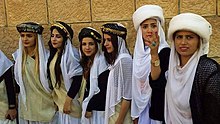Etnoreligia grupo: Malsamoj inter versioj
Kreita per traduko de la paĝo "Ethnoreligious group" |
(Neniu diferenco)
|
Kiel registrite je 21:49, 12 aŭg. 2020
Etnoreligia grupo estas etno, kies membroj estas unuigitaj ankaŭ per komuna religio.

Ĝeneralo, etnoreligiaj grupoj difinas sian etnan identecon nek nur per praula heredaĵo, nek nur per religia aparteneco, sed normale per kombino de ambaŭ. Etnoreligia grupo havas komunajn historion kaj kulturan tradicion, kiu povas esti difinita kiel religio. En multaj okazoj etnoreligiaj grupoj estas etnokulturaj grupoj kun tradicia etna religio; en aliaj okazoj etnoreligiaj grupoj komenciĝis kiel komunumoj unuigitaj per komuna kredo, kiuj pro endogamio evoluigis kulturajn kaj praulajn ligojn.[1][2] Juraj difinoj de etnoreligia grupo povas malsami de la ĵusdonita difino.
La identecoj de kelkaj etnoreligiaj grupoj estas plifortigitaj pro la sperto vivi ene de pli granda komunumo kiel aparta malplimulto. Etnoreligiaj grupoj povas esti ligitaj al etna naciismo, se la etnoreligia grupo posedas historian bazon en specifa regiono.[3] En multaj etnoreligiaj grupoj oni emfazas religian endogamion kaj la samtempa malinstigo de interkredaj geedziĝoj aŭ interkreda seksumo, kiel rimedo konservi la stabilecon kaj historiam longedaŭrecon de la komunuma kaj kulturo.
- ↑ Yang and Ebaugh, p.369: "Andrew Greeley (1971) identified three types of relationships in the United States: some religious people who do not hold an ethnic identity; some people who have an ethnic identity but are not religious; and cases in which religion and ethnicity are intertwined. Phillip Hammond and Kee Warner (1993), following Harold J. Abramson (1973), further explicated the “intertwining relationships” into a typology. First is “ethnic fusion,” where religion is the foundation of ethnicity, or, ethnicity equals religion, such as in the case of the Amish and Jews. The second pattern is that of “ethnic religion,” where religion is one of several foundations of ethnicity. The Greek or Russian Orthodox and the Dutch Reformed are examples of this type. In this pattern, ethnic identification can be claimed without claiming the religious identification but the reverse is rare. The third form, “religious ethnicity,” occurs where an ethnic group is linked to a religious tradition that is shared by other ethnic groups. The Irish, Italian, and Polish Catholics are such cases. In this pattern, religious identification can be claimed without claiming ethnic identification. Hammond and Warner also suggest that the relationship of religion and ethnicity is strongest in “ethnic fusion” and least strong in “religious ethnicity.” Recently, some scholars have argued that even Jews’ religion and culture (ethnicity) can be distinguished from each other and are separable (Chervyakov, Gitelman, and Shapiro 1997; Gans 1994)."
- ↑ Hammond and Warner, p.59: "1. Religion is the major foundation of ethnicity, examples include the Amish, Hutterites, Jews, and Mormons. Ethnicity in this pattern, so to speak, equals religion, and if the religious identity is denied, so is the ethnic identity. [Footnote: In actuality, of course, there can be exceptions, as the labels "jack Mormon," "banned Amish," or "cultural Jew" suggest.] Let us call this pattern "ethnic fusion."
2. Religion may be one of several foundations of ethnicity, the others commonly being language and territorial origin; examples are the Greek or Russian Orthodox and the Dutch Reformed. Ethnicity in this pattern extends beyond religion in the sense that ethnic identification can be claimed without claiming the religious identification, but the reverse is rare. Let us call this pattern "ethnic religion."
3. An ethnic group may be linked to a religious tradition, but other ethnic groups will be linked to it, too. Examples include Irish, Italian, and Polish Catholics; Danish, Norwegian, and Swedish Lutherans. Religion in this pattern extends beyond ethnicity, reversing the previous pattern, and religious identification can be claimed without claiming the ethnic identification. Let us call this pattern "religious ethnicity"" - ↑ Eraro vokante la ŝablonon {{citaĵo el la reto}}: la parametroj url kaj titolo estu ambaŭ precizigitaj .